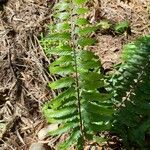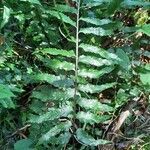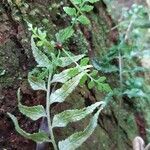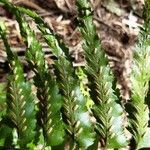Plants terrestrial, epilithic or epiphytic. Rhizome short, erect to suberect, to 20 mm long, to 5 mm in diameter, set with roots, crowded persistent stipe bases and scales, scales chartaceous to thinly chartaceous, ferrugineous to castaneous, clathrate, adnate, lanceolate, cordate, margins regularly set with short and long filiform outgrowths terminating in an enlarged obovate thin-walled cell, apex terminates in an enlarged thin-walled cell, to 16 mm long, to 3 mm wide. Fronds crowded, caespitose, arching, to 820 mm long; stipe atrocastaneous, matt, adaxially sulcate, to 170 mm long, to 3 mm in diameter, initially densely scaled, scales chartaceous, castaneous, sessile, linear to filiform, cordate to cordate-imbricate, larger scale margins regularly set with short and long filiform outgrowths terminating in an enlarged thin-walled cell, filiform scales with gland-like cells and short outgrowths terminating in an enlarged thin-walled cell at the base, apex terminates in an enlarged thin-walled cell, to 10 mm long, to 1 mm wide; lamina anadromous, 1-pinnate, lanceolate, to 650 mm long, to 190 mm wide, with up to 21 petiolated pinna pairs, with a proliferous bud adaxially on the rachis near the apex; rachis firm, atrocastaneous, adaxially sulcate, moderately set with filiform scales similar to those on the stipe; pinnae petiolate, petiole to 2 mm long, opposite to alternate, basally more widely spaced than apically, the 2-3 basal pairs generally gradually reduced, firmly herbaceous, inequilaterally lanceolate, often somewhat falcate, acroscopically truncate to broadly cuneate, basiscopically narrowly to broadly cuneate, dentate, usually with alternating shallower and deeper incisions, to 120 mm long, to 20 mm wide, adaxially sparsely set with filiform scales along the costa similar to those on the stipe, abaxially sparsely set with filiform scales along the costa and veins similar to those on the stipe, to 2.5 mm long; costa adaxially raised, convex. Venation anadromous, evident, pinnately branched, branches forked, ending in the teeth near the margin. Sori linear, inframedial, at or above a vein fork, to 8 mm long; indusium chartaceous, stramineous, linear, entire, to 8 mm long, 1.4 mm wide; sporangium long-stalked, uniseriate, 3-seriate below the capsule, capsule globose in lateral view, annulus (17-)19(-20)-celled, epistomium 2-celled, hypostomium 4-celled. Spores 64 per sporangium, brown, elliptic, monolete, perispore forms broad reticulate wings, exospore (40-)46.3(-50) x (30-)31.8(-34) µm.
More
Rhizome erect, up to 20 mm in diameter, set with reddish-castaneous, somewhat serrulate, lanceolate, attenuate rhizome-scales c. 10 mm long with a somewhat darker central portion and narrow paler borders (composed of hyaline thin-walled cells). Fronds tufted, herbaceous, gemmiferous; stipe matt grey-green, densely set at first with sinuose hair-like scales; lamina ovate-lanceolate, usually up to 540 x 160 mm (rarely 1050 x 240 mm), pinnate, basal pinnae slightly reduced; pinnae in up to 28 pairs, lanceolate-attenuate, base broad and unequally cuneate, margin dentate with usually alternating deeper and shallower incisions, a single vein forking to end in this pair of teeth, upper surface glabrous, lower surface set with occasional minute substellate scales. Sori borne along outermost branch-vein of a fork, c. 6 mm long; indusium pale membranous, oblong-elliptic, entire, c. 0.7-1.5 mm broad.
Rhizome erect to suberect, up to 5 mm in diam., with stipe bases and reddish brown, lanceolate scales, up to 18 x 2 mm, irregularly with a few marginal outgrowths. Fronds caespitose, arching, up to 400 mm long. Stipe firm, dark brown, up to 200 mm long, up to 2.2 mm in diam., proximally densely scaled. Lamina 1-pinnate, lanceolate, up to 800 x 170 mm, with 13-28 pinna pairs, usually proliferous near frond apex. Pinnae herbaceous, lanceolate, falcate, margins incised 1/3 to costa into narrow, rounded lobes or teeth, glabrous adaxially, sparsely scaled abaxially. Sori linear, 3-8 mm long. Indusium entire, linear to narrowly elliptic, up to 1 mm wide.
Rhizome erect, set with reddish castaneous rhizome scales. Pinnae margins with alternating deeper and shallower incisions. Fronds gemmiferous. Straight basiscopic edge very much shorter than pinna itself. Sori borne along outermost branch vein of a fork.





